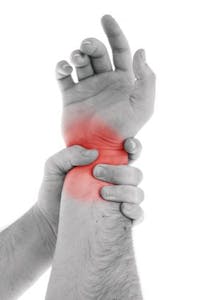Carpal Tunnel Syndrome

Carpal tunnel syndrome is a compression of the median nerve within the carpal tunnel. There is pain, tingling, and in severe cases, numbness in the thumb, index middle and ½ of the ring finger. It is typically caused by repetitive tasks involving the hand and wrist. Typing with the wrists resting on hard surfaces can result in this problem.
It is often worse at night or with driving and can lead to loss of grip strength and coordination. As the problem progresses, atrophy (muscle wasting) of the thumb muscles may occur.
Treatment typically consists of splinting the wrist in a neutral position (no bend in the wrist in either direction), anti-inflammatory medication, and most importantly, activity modification such as wearing a padded glove during cycling. Surgical release of the transverse carpal ligament is often performed before muscle wasting occurs. Physical therapy follows to help restore range of motion, strength, and to educate the patient of factors that can lead to a reoccurrence of the problem.
Fractures of the Forearm/Wrist
Fractures of the wrist and hands are commonly named for their anatomical location, how they occurred, or a doctor that discovered or studied the given type of fracture.
The fingers are susceptible to fracture in household mishaps, recreational injuries and work-related trauma.
Most hand fractures are stable and do not require surgery. However, occasionally, fractures will not heal without appropriate surgical intervention. Internal support or “hardware” is necessary to stabilize fractures. The therapist may apply a form fitting, custom thermoplastic splint to protect the fracture during healing. These splints may be removed for exercise and hygiene.
Most therapy programs commence days to 3 or 4 weeks post op, to regain motion, decrease pain, and reduce swelling. Rehabilitation may continue for weeks or months to restore range of motion (ROM) and strength.
Distal Radius Fracture Colles, Smith Fractures
These fractures often result from a fall onto an outstretched hand or because of a direct blow. Pain, tenderness, and deformity are common. X-rays are used to rule in/out a fracture.
Treatment for a fracture involves “closed reduction” in which the bones are moved back into alignment.
If the bones cannot be moved back into the proper position manually, open reduction and often internal fixation is used. This means that the bones are surgically positioned next to each other and might be pinned, screwed or wired together.
Early intervention/rehabilitation is helpful to reduce pain, increase range of motion, and ultimately restore strength and function. Wrist supports and custom splints are helpful to protect the area so optimal healing can occur.
